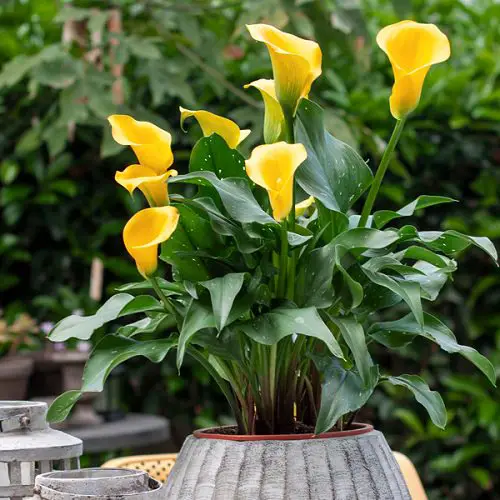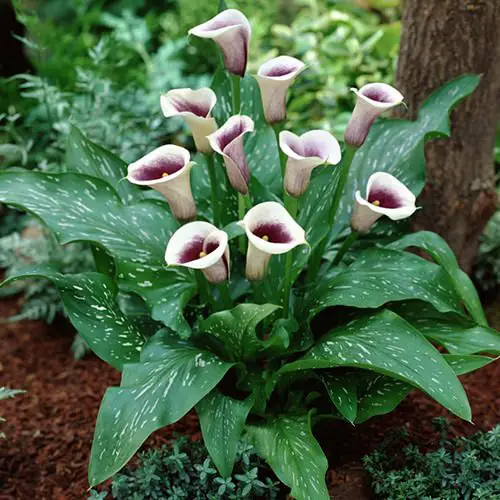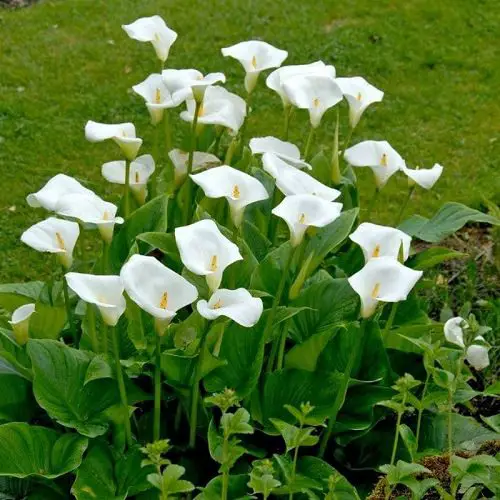Wondering How to Grow Arum Lilies in a few simple steps? Follow our detailed guide to learn everything in detail!
Arum Lily Care and Growing are easy if you follow the procedure correctly. Read on to learn about How to Grow Arum Lilies in this detailed article below!
Arum Lily Information

The Arum Lily plant belongs to the family called Araceae. It is native to South Africa, where it grows naturally in wetlands and marshy areas. Zantedeschia is known for its distinctive appearance and elegant white flowers.
The Zantedeschia has large, glossy, heart-shaped leaves that grow on tall stalks. Its flowers consist of a white spathe, which is a modified leaf that wraps around a yellow spike called a spadix. These flowers are not only visually appealing but also emit a pleasant fragrance. In their natural habitat, Arum Lilies are commonly found growing alongside stream banks, pond margins, and marshes. Zantedeschia typically reach a height of 2 to 3 feet, showcasing their impressive stature.
One of the unique characteristics of Zantedeschia is its ability to adapt to different environments. It can grow both in the wild and as a cultivated plant in gardens. Additionally, the plant has a fascinating way of attracting pollinators. Zantedeschia emits a scent that resembles rotting meat, which attracts flies that act as pollinators.
Botanical Name: Zantedeschia
Common Names: African Lily, Brosimun aethiopica, Egyptian Lily, Altar Lily, Arum Lily, Calla aethiopica, Calla Lily, Florist’s Calla, Lily Of The Nile, Pig Lily
USDA Zones: 8-11
Check out the best Daylily varieties here
Arum Lily Plant Propagation
The simplest and quickest way of propagating Arum Lily is by division of rhizomes or plant bulbs. You can also grow it from seeds, but it is a time-consuming process.
- Take Zantedeschia out from the pot or garden and clean the soil around the roots to have a good look at the bulbs. Using a sharp knife, divide the clumps with a bit of root attached to them.
- Prepare a pot that is about 10-12 inches deep and fill it with fertile soil that has been loosened. This will provide a suitable growing environment for the plant.
- Sow the rhizomes at a depth of 4-6 inches and cover them with a thin layer of the potting mix. Sowing one rhizome per pot is advisable as the plants spread their leaves wide and far.
- Plant the rhizomes in the pot with the flat surface facing downwards and the pointed end facing upwards. The new shoot will emerge from the pointed end, so it’s important to position it correctly.
- After planting, water the pot thoroughly and place it in a location with abundant sunlight to ensure optimal growth.
New shoots appear within 2-3 weeks of planting the rhizomes.
Pro Tip: Divide the rhizomes in late fall to let them heal by spring before the onset of their growing season.
Best Pot for Arum Lily
Don’t know How to Grow Arum Lilies in pots? Opt for a pot that provides enough space for the plant’s roots to grow and expand comfortably. A pot with a diameter of 10-12 inches (25-30 cm) and a depth of at least 10 inches (25 cm) is generally a suitable choice. This size allows Zantedeschia to establish a robust root system and provides ample room for the plant to thrive.
Ensure that the pot has drainage holes at the bottom to prevent waterlogging and promote healthy root development. A well-sized pot will provide the necessary stability and growing space for your Arum Lily, allowing it to flourish and showcase its beautiful foliage and blooms.
Here are Plant Pot Sizes from Inches to Gallon
Requirements for Growing Arum Lily
Sunlight
To successfully grow Arum Lily, you need to provide it with the right sunlight and location. Place the plant in a spot that receives bright, indirect sunlight. Zantedeschia prefers a partially shaded area, so avoid direct sunlight that can scorch its leaves.
Find a location where the plant can get a few hours of the morning or late afternoon sun while being protected from intense midday rays.
Soil
The arum prefers evenly moist, well-draining soil rich in organic matter. Amend the soil with a humus-rich fertilizer and a handful of perlite to ensure proper drainage.
Learn some Great Tips to Rejuvenate Your Old Soil here
A slightly acidic to neutral pH level (around 6.0 to 7.0) is ideal for this plant. If your soil is heavy or compacted, you can improve its drainage by adding organic compost or peat moss.
Watering
Watering is an important aspect of caring for Arum Lily. Keep the soil consistently moist but not overly saturated. Water the plant deeply whenever the top inch of soil feels dry to the touch.
Here are the best ways to water plants
You should avoid letting the soil completely dry out between waterings, as this can negatively affect the Zantedeschia’s health. It’s important to strike a balance by providing adequate moisture without causing waterlogged conditions.
Temperature & Humidity
Arum Lily prefers moderate temperatures. It thrives in a range of 65 to 75°F (18 to 24°C) during the day and slightly cooler temperatures at night. Avoid exposing the plant to extreme heat or cold.
Zantedeschia enjoys average to slightly higher humidity levels, but it can tolerate drier conditions. If the air becomes too dry, you can increase humidity around Zantedeschia by misting it with water or placing a tray filled with water near the plant.
Here are 10 Ways To Increase Humidity For Houseplants That Work
Arum Lily Care

Fertilizer
Arum lily is a demanding plant and needs regular fertilization. Feed Zantedeschia with an all-purpose liquid fertilizer every month during the growing season for a beautiful flower show.
Want to Make Organic Fertilizers from Kitchen Scraps? Click here
Alternatively, organic manure such as cow dung compost, bone meal, and fish emulsion also boosts plant growth. Applying fertilizer once every two to three months is generally sufficient to provide the necessary nutrients for your Arum Lily. Do not fertilize the cala lilies in the dormant periods.
Overwintering
When it comes to overwintering Arum Lily plants, caring for them is straightforward in mild winter climates (USDA Zones 8-11). However, in cooler zones, you’ll need to take steps to protect the Zantedeschia bulbs from frost and ensure their survival.
To safeguard your Arum Lily bulbs, begin by carefully digging them up before the arrival of frost. Once dug up, place the Zantedeschia bulbs in a sunny location for a few days to allow them to dry.
Pruning
Pruning helps maintain the appearance and health of Arum Lily plants. After the flowering season, you can remove any dead or yellowing leaves by cutting them off at the base. This will help prevent the spread of diseases and improve the overall aesthetic of Zantedeschia.
Be sure to use clean and sharp pruning shears to make clean cuts, minimizing the risk of infection.
Pests and Diseases
Arum Lily plants can be susceptible to a few pests and diseases. One common pest is the aphid, which can be controlled by spraying the plant with a gentle stream of water or by using insecticidal soap.
Another potential pest is the snail or slug, which can be deterred by placing barriers or using organic slug repellents around the plant.
Arum Lily plants can be prone to root rot if they are overwatered or planted in poorly drained soil. To prevent this, ensure the soil has good drainage and avoid overwatering.
If you notice any signs of disease, such as wilting or yellowing leaves, it’s important to take action promptly to prevent further damage.
Frequently Asked Questions
1. Can I Grow Arum Lilies From Seeds?
While it is possible to grow arum lilies from seeds, it is a more challenging and time-consuming method compared to propagating them from rhizomes. For best results, it is recommended to obtain healthy rhizomes from a reputable source.
2. Why Are the Leaves of My Arum Lilies Turning Yellow?
Yellowing leaves on arum lilies can indicate overwatering, underwatering, or nutrient deficiencies. Ensure proper watering practices, maintain balanced moisture levels, and consider adjusting your fertilization routine to address any nutrient deficiencies.
3. Where to Keep Arum Lily in Colder Zones?
For colder zones, it’s advisable to move the potted Arum Lily plant indoors or to a greenhouse. Find a spot with a temperature around 50°F (10°C) to provide a suitable winter environment. During this time, reduce the frequency of watering, as the Zantedeschia’s growth slows down during the winter months.
4. Is There an Orange Arum Lily?
No, there is no naturally occurring orange Arum Lily. The common Arum Lily varieties typically have white or cream-colored flowers.
However, there is calla lily arum that is found in orange colors naturally. This calla arum lily is known for its elegant trumpet-shaped blooms and comes in a variety of colors, including white, yellow, pink, purple, and, yes, orange.
5. Is Arum Lily Toxic?
Yes, Arum Lily is toxic to humans and animals if ingested. Zantedeschia contains calcium oxalate crystals, which can cause irritation and discomfort if consumed. The crystals can irritate the mouth, throat, and digestive system, leading to symptoms such as burning sensations, swelling, and difficulty swallowing.
Arum Lily Safety Note: It’s important to handle Arum Lily plants with care and keep them out of reach of children and pets to avoid any accidental ingestion. If ingested, it is recommended to seek medical attention or contact a poison control center immediately.





I bought this last week and have done anything with it except water it. It looked great when I bought it and has signs of new growth but one or two of the established leaves are yellowing at the edges. Can you tell me what may be causing this? PS very informative inspirational web site
I’m not an expert but yellow leaves in plants usually means overwatering.
I need advice on cultivating arum lilies in standing water
Thanks
i had the arum lily but dont know if it survied this last winter i see no new shoots coming up when should they start poking thru the groung in abbotsford bc zone 8
Not sure but maybe Canadian growing. Ones are different than US. In Ct I’m in 6 and an Arum Lilly won’t survive outdoors for winter.
Will white arum lilies grow in Brisbane I haven’t had success so far
Arum Lillies will grow very successfully in a pond but in the Autumn it must be removed and planted into the ground or the freezing water will kill it. Sadly I know this from experience. So too much water in not a problem. Yellow leaves could be caused by a lack of nutrients. Mine is in chalky soil, has been watered when required, is in semi shade and has flowered well this year. Another I know of has grown in clay/silty soil, been well watered, situated in full sun with north wind protection and has produced more flowers than mine. Both have had leaf yellowing but the leaves are simply removed.
Oh and we live in chilly East Yorkshire.
I have a ‘black’ arum lily in a pot. This year, the actual flowerhead is filled with small bulbs. Can I plant these?
Yes. Remove the fleshy outer coat, then plant the small black seeds about 1cm below the surface. They will sprout in the spring.
love the arum lily in the flower beds but mine all died as it was just so cold this winter now bought one and have put it in a pot when should i put it outside in abbotsford bc just love them
I have a white arum lily from a plant my Grandmother had, and she died in 1963! I keep it indoors in a pot. I haven’t had any flowers for a while, but it’s healthy, and I’m just glad it’s still alive!
Why is my Callalily a double plus then growing a Nother one right on the same stand beside it
I have a almost black army lily. Is the care the same as a white one?
Arum Lillies are not nice plants at all.
Please grow something else from this wonderfull catalogue.
They are poisonous, extremely invasive to the natural environment, almost impossible to kill off and dont even help bees. In Australia, they are a notifiable weed.
Thank you.
You are 100% right if you live in OZ They are not indigenous to your country and them and any other non indigenous trees and plants should not be encouraged. In South Africa, Arums are lovely (bees adore them) gardens are full of them.
Enjoy your indigenous garden!!
What can I feed my yellow arum lily in pot to improve the colour. When I got it, the flowers were bright yellow. Ive transplanted it into a bigger pot and placed it outside where it gets only morning sun. The leaves looks fine but the flowers are now a pale yellow.